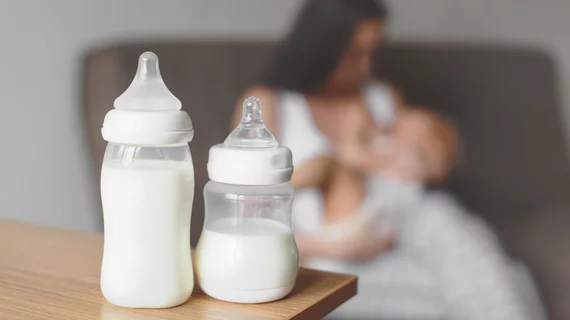Radiologists urge practices to grant breast-pumping RVU credits to offset new moms’ productivity losses
A group of radiologists are urging practices to grant breast-pumping providers work relative value unit credits to help offset productivity losses during their shifts.
The University of California, San Francisco, has already championed such a “lactation credit model,” experts wrote Tuesday in Clinical Imaging. It gives UCSF docs 30-minute “holds” for pumping during each half-day clinic session, and a 1.5 wRVU comp each instance for a year after returning from maternity leave.
Kristin Porter, MD, PhD, and colleagues believe this employment perk should become commonplace for radiology practices that use productivity models. Otherwise, physician mothers are being forced to choose between caring for their baby or potentially losing out on income.
“A lactation credit program in radiology could be accomplished in a similar fashion to the disparate ways groups account and compensate for the nonclinical responsibilities of radiologists, such as consultations, administrative responsibilities, and teaching and/or research productivity in academics,” Porter, with the University of Alabama at Birmingham’s Department of Radiology, and co-authors wrote June 29. “By assigning a value unit to these activities, an appropriate time-value credit could be assigned to a breast-pumping session. Such a lactation credit program offers a creative solution for overcoming a longstanding and under-recognized penalty imposed on breastfeeding parents,” they added.
Despite healthcare’s shift toward value, many radiologists are still paid based one volume. One analysis estimated about 72% of docs are paid a base salary plus a bonus, typically tied to RVUs. Even in practices without such productivity targets, leaders should consider other changes such as incentivizing team members to cover for pumping peers, Porter et al. wrote.
About 44% of radiologists do not breastfeed their infant as long as desired, according to one estimate, and often, inadequate time is the primary reason. Addressing this concern is critical if the specialty wants to bolster well-being and minimize burnout, the editorialists argued.
“Breastfeeding has medical and economic benefits and providing an environment supportive of breastfeeding should be a priority in radiology if our specialty genuinely wishes to promote diversity, equity and inclusion,” they concluded.
You can read the rest of the piece in the New York Roentgen Society’s official journal here.

